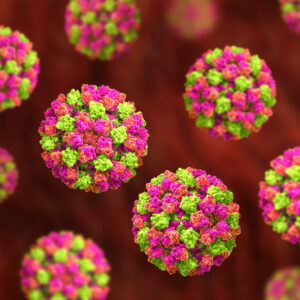Norovirus
The Native Antigen Company offers both recombinant norovirus antigens and highly specific antibodies to support research and assay development into Norovirus biology and infection.
Norovirus Background
Previously known as Norwalk virus, NoV is a major cause of non-bacterial outbreaks of acute gastroenteritis worldwide. Norovirus can infect individuals of all ages and is a major cause of gastroenteritis in contained environments, such as schools, care-homes, hospitals and cruise ships. Symptoms of NoV infection develop rapidly and include vomiting, nausea, abdominal cramps and diarrhoea (Robilotti, et al.). In most cases, NoV infection is a self-limiting disease that may last 1-3 days, but can cause complications in very young, elderly and immunocompromised individuals. In some severe cases, NoV infection can result in dehydration, hospitalisation and death (CDC).
NoV is highly contagious. It can persist in the environment and is resistant to most household disinfectants. Transmission of NoV primarily occurs through the faecal-oral route and through contact with infected individuals, contaminated clothing, surfaces, food and water. In the USA, NoV is the leading source of food related illness (CDC).
Diagnosis of NoV infection is commonly performed using real-time reverse transcriptase polymerase chain reaction (RT-PCR) assays. Enzyme-linked immunoassays are also employed to detect NoV in stool samples, but are reported to lack sensitivity. Currently, no licensed vaccine is available for the prevention of NoV infection. However, recent reports suggest that significant progress is being made to develop a vaccine that may provide short term immunity against GI.1 and GII.4 NoV genotypes (Takeda).
References
- Karst SM. (2010). Pathogenesis of noroviruses, emerging RNA viruses. Viruses.Mar;2(3):748-81. PMID: 21994656
- Robilotti E, Deresinski S, Pinsky BA. (2015). Norovirus. Clin Microbiol Rev.Jan;28(1):134-64. PMID: 25567225
- Centers for disease control and prevention: Norovirus, Clinical overview
- Centers for disease control and prevention: Norovirus, Burden of norovirus illness and outbreaks
- Takeda press release: Takeda initiates world’s first norovirus vaccine field trial
Norovirus Antigens

Mouse Anti-Norovirus GI Antibody (NP28)
$454.04 excl. VAT
Mouse monoclonal antibody specific for Norovirus genotype II (Clone ED10)
Price range: $737.83 through $2,215.56 excl. VAT
Mouse monoclonal antibody specific for Norovirus genotype II (Clone JB3)
Price range: $737.83 through $2,215.56 excl. VAT
Norovirus Antibodies
Questions?
Check out our FAQ section for answers to the most frequently asked questions about our website and company.





